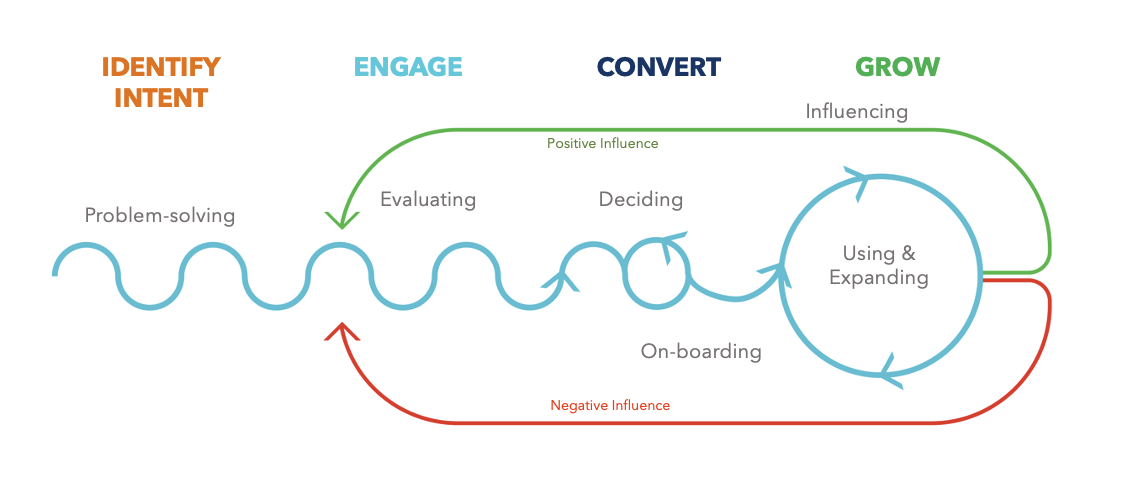One of the biggest challenges in developing your account-based marketing strategy is how to explain it to your executives and colleagues, especially the importance of alignment and collaboration between sales and marketing. It’s understandable. Account-based marketing is complicated, and it takes a long-term commitment to do it at scale. Above all, it requires breaking down the silos between sales, marketing, and SDRs.
I use a metaphor about a door to explain it.
So What is this Account-Based Marketing Strategy Door Metaphor?
People get sick of jargon, and ABM is a jargon-heavy topic. ABM is a festival of Three-letter Acronyms or TLAs.
The way I think about an account-based marketing strategy is that it is all about getting the right people to show up at your door, getting them through the door, sitting them down, and closing the sale.
Imagine looking out and seeing 10,000 people outside your door. Your goal is to get 10 of these 10,000 to become customers. The role of marketing is to bring the right people to the door. The SDRs objective is to get the best prospects through the door and to get them seated. The role of sales is to convince 10 of them to buy.
Demand Generation and Demand Capture – A Foundation of Your Account-Based Marketing Strategy
One of the changes in B2B and account-based marketing strategy is embracing the notion of Demand Generation and Demand Capture. This is different and better than straight lead generation. Here is how ChatGPT explains the difference between demand generation, demand capture, and lead generation.
Demand generation, demand capture, and lead generation are all terms related to marketing and sales. Here’s a brief explanation of each:
- Demand generation: Demand generation is the process of creating awareness and interest in a product or service among a target audience. This can involve various tactics, such as content marketing, social media, email marketing, events, and advertising. The goal of demand generation is to create a need or desire for a product or service so that potential customers become interested and engaged.
- Demand capture: Demand capture refers to the process of capturing existing demand for a product or service. This often involves tactics such as search engine marketing (SEM), search engine optimization (SEO), and retargeting ads. The goal of demand capture is to capture the attention of people who are already searching for a product or service like yours, and guide them to your website or landing page.
- Lead generation: Lead generation is the process of identifying potential customers (i.e., leads) and collecting their contact information, such as email addresses or phone numbers. This can involve various tactics, such as content marketing, webinars, gated content, and social media. The goal of lead generation is to build a list of potential customers who have expressed interest in your product or service, so that you can follow up with them and eventually convert them into paying customers.
In summary, demand generation focuses on creating awareness and interest in a product or service, demand capture focuses on capturing existing demand, and lead generation focus on identifying and collecting contact information for potential customers.
Demand Generation – Getting the Right People to The Door
A simple way to think about demand generation is that it is about bringing the right people to your door. First, you need to be clear about who the right customers are for you. This is a decision on precisely what a best-fit customer looks like. It’s also a decision about who you are NOT going to attract. Ideally, you can use intent data to determine who is in-market.
Possibly, out of the 10,000 people outside your door, only 1000 meet your criteria of a best-fit customer, and only 200 of these are showing any intent to buy something new. Your job is to pinpoint these 200 prospects and bring them to your door.
Demand generation means you will use different ways to attract only these 200 accounts. For example, running ads on LinkedIn targeting a narrow set of titles at only these 200 accounts, using messaging and content tailored to their specific issues.
While it may seem obvious, remember that traditional broad-reach B2B marketing would mean advertising to all 10,000 people (accounts) with more general messaging.
If you succeed, the 200 in-market accounts will appear outside your door.
By the way, this is primarily the domain of the marketing department. The key thing is that marketing and SDRs are in lock step.
Demand Capture – Getting them through the Door
In simple terms, demand capture is about getting these 200 accounts to cross the threshold and get them seated to meet with sales.
The main change that happens with ABM is close coordination between marketing and SDRs. When we help clients implement, their account-based strategy is to schedule regular meetings between the SDR team and marketing specifically to look at which opportunities are showing intent, i.e., which of the 10,000 prospects outside the door are responding to the demand generation tactics. This is where intent data can be incredibly useful. It allows you to see who is appears to be in-market.
This joint analysis of which accounts show intent can fundamentally change how the SDRs work. For example, we helped a client start using intent data. Within a week of integrating third-party intent data into their CRM, the SDRs switched their daily routine from calling a cold list of prospects to focusing on accounts that were showing intent. The results were phenomenal. Within a week, they identified an opportunity with a large healthcare system. Within 90 days, they booked 31 meetings and generated 17 qualified opportunities, resulting in $2.7 million in deals.
This is where lead generation comes in.
Traditional B2B marketing typically uses more broad-reach tactics. For example, using webinars to get hundreds of prospects to register. This still has its place in an account-based marketing strategy.
The main difference between lead generation in an ABM scenario is that you focus on generating leads with in-market prospects. As you react to signals that the prospects are in-market, you can use more precise tactics, even more personalized outreach, and lead generation tactics to get these 200 to cross the threshold.
Converting and Growing – Closing the Sale and Keeping Them in the House
So now you have delivered some of the 200 prospects across the threshold. This is where the SDRs qualify them and then introduce them to a sales executive.
How can ABM help close deals?
Your ABM program should include tactics to help accelerate the sales cycle and increase the likelihood of conversion. This might include creating personalized web pages for prospects with curated content and a personal video message from your CEO.
The other key thing to consider in your account-based marketing strategy is how you measure performance. As we detailed in this post, one of the key changes is a focus on revenue performance, such as deal size and sales acceleration.
Lastly, ABM doesn’t stop at a closed deal. ABM is just as much about how you grow accounts as it is about winning new ones. Gaining account insight about your current customers will underpin your account-based marketing strategy.
Implementing an account-based marketing strategy at scale can take several years. Many companies focus their initial efforts on getting new accounts. Over time, maybe as later as year 3 in the ABM journey, companies that are active ABM practitioners change their focus to growing accounts. In our podcast, with Kelly McDermott, from Caregility, she explains this journey in great detail.
Total Customer Growth
We hope this post helps provide a simple metaphor for ABM. As a firm, we think holistically about the whole ABM process. Our approach is based on the long-term customer journey from prospect to becoming a customer, expanding their relationship with you, and becoming influencers on your future prospects. We call this Total Customer Growth.

Watch this space on this topic. There is a lot more to come here.
Photo by Alex Padurariu on Unsplash

